INTRODUCTION:
It was a bright, but soon to be long day on my journey to the Museum of Modern Art (MOMA). Throughout my childhood, I’ve never really had the opportunity to visit art museums due to my lack of interest in art during that time. As a result, I was very excited to visit the MOMA, as it’ll mark my first ever art museum visit in my life. After getting off of 7th Avenue station, I took a 20 minute walk straight towards the outside of the MOMA. Immediately when reaching there, I was impressed by the smooth entrance I was able to get into the museum. It was a rapid process that involved going through security, double checking that everything is in my bag, getting my CUNY ticket, and walking towards my first ever art exhibit.
SECTION 1 (FREDERICK DOUGLASS ART SECTION):
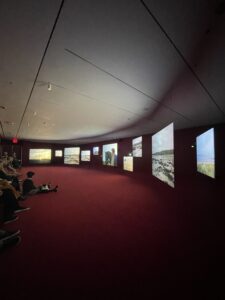
“Lessons of the Hour” by Sir Issac Julien
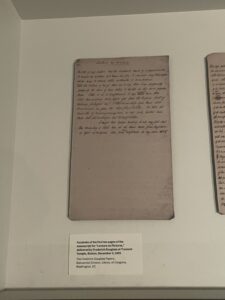
“Lecture on Pictures” by Frederick Douglass.jpg
After walking around the 1st floor for a bit, I noticed a huge crowd of people walking towards a room that seemed to show some sort of movie in there. Upon walking towards the crowd, I was amazed to witness the popularity and works of Frederick Douglass. It was a name I hadn’t seen since reading his book titled “Narrative of the Life of Frederick Douglass” in middle school. Even though I had a small glimpse of who Frederick Douglass was, reading his written documents on display gave me a refresher on his life under enslavement and his contribution to the abolitionist movement. It was also interesting to find a movie that was crafted in his honor, and was thus impressed by the clear historical events that Julien depicts in his Douglass’s narrative.
SECTION 2 (HISTORICAL ART SECTION):
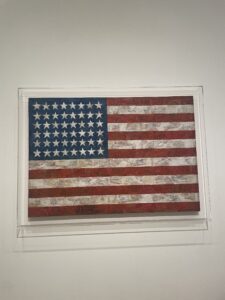
“Flag” by Jasper John
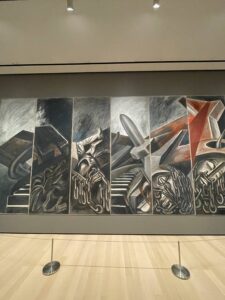
“The Charnel House” by Pablo Picasso
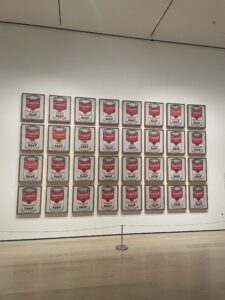
“Campbell’s Soup Cans” by Andy Warhol
It was also very fascinating to see the works that were drawn within the 19th-20th century because they depicted the situations that were arising at that moment. Jasper Johns’s ”Flag”, for example, allowed me to see notable differences between our current flag and the flag before the United States acquired both Hawaii and Alaska as official states. Upon searching the modern-day American flag, I was able to see the pattern of rows to be strikingly different and the brightness of the color that was painted in contrast to the computer-generated image of the modern-day flag. Looking through Pablo Picasso’s “The Charnel House” I was fascinated by the message he wanted to convey of the horrors of World War 2. Picasso, at first, was never one bit interested in painting anything that pertains to the theme of war, however the spread of Nazism and dictatorship in some parts of the world strongly persuaded him to illustrate to his audience the negativity those ideals played in the 1940s. Upon my journey on these historical paintings, I’ve realized that many of them were referred to as “Documents” in my history classes, as they were used mostly to support our historical claims. An example of this can be “Campbell’s Soup Cans” painting, which highlighted the typical, universal diet of many American workers during the 20th century. I remember in my U.S. history class, I had to use this painting as evidence to describe the toughness the American soldiers had to fight in the Cuban wars, mainly through eating soup meals day after day.
SECTION 3 (MATERIALISTIC ART):
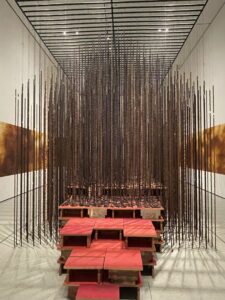
“House of Hope” by Montien Boonma
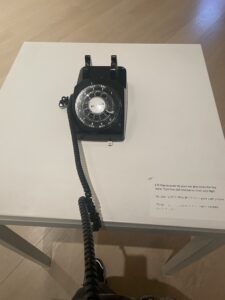
“Dial-a-poem” by John Giorno
It was also refreshing to see other pieces of art that were used to depict art other than paintings. Coming from a Chinese family that follows certain Buddhist traditions, Montien Boonma’s “House of Hope” reminded me of the very first temple I went to in China. The beads that were used for decoration reminded me of the relics the monks would put on when giving a lecture to an audience, alongside the red staircase illustrating to me happiness and prosperity just as the Chinese cultures would define the color. At the “Dial-a-poem” exhibit by John Giorno, I was able to explore auditory art by someone who gave it away to the public for free. By dialing the number the instructions asked me to, I was quick to pick up the stunning poem John Giorno had crafted within minutes about his opposition to the Vietnam War. It made me a little bit upset, especially hearing an artist reflecting upon the tragic loss of lives that were occurring from the war.
SECTION 4 (ABSTRACT ART SECTION):
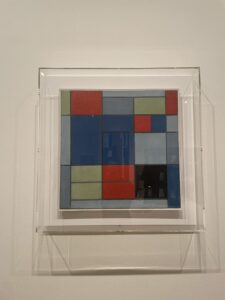
“Exhibition C” by Piet Mondrian

“One: Number 31, 1950” by Jackson Pollock
The abstract art exhibit reminds me of the type of art that I’ve seen in my elementary school art room. The most notable painting my art teacher would clearly show on her wall was the “Exhibition C” painting by Piet Mondrian. To my four-year-old self at that time, nothing in the painting really stuck to me as art rather just a bunch of shapes jumbled up together. I feel like this perception was developed by seeing much more complicated portrait and landscape drawings in social media. It wasn’t until I discovered Jackson Pollock’s abstract paintings that I truly discovered the uniqueness of the drawings I would see in my elementary school art room. It was meant as a way to express one’s free mind when drawing, and how art especially is meant to communicate to the audience and doesn’t have to include any complicated details.
CONCLUSION:
Overall, my childhood perception of trips to art museums being boring was quickly proven wrong when I visited the MOMA and discovered many hidden treasures, resulting in my perception of art to change. I saw artwork that ranged from cultural paintings, historical pieces of art, and abstract art paintings, which altogether sparked my interest in researching more about international works of art that I hadn’t learned about in school. To my surprise, I discovered that many famous paintings convey deep messages, and thus I strongly encourage whoever is reading this to venture out to the MOMA and explore other paintings rather than just paying a visit just to see the “Starry Night”.


